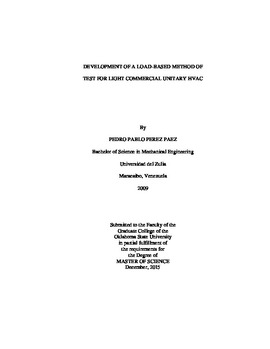| dc.contributor.advisor | Cremaschi, Lorenzo | |
| dc.contributor.author | Perez Paez, Pedro Pablo | |
| dc.date.accessioned | 2017-02-22T22:13:01Z | |
| dc.date.available | 2017-02-22T22:13:01Z | |
| dc.date.issued | 2015-12-01 | |
| dc.identifier.uri | https://hdl.handle.net/11244/49006 | |
| dc.description.abstract | Packaged unitary HVAC equipment and systems are factory-made assemblies that often provide heating and cooling to buildings all year round. In the commercial sector only, roughly 60% of the commercial building floor space of the U.S. use packaged rooftop air conditioning units. RTUs have an associated annual primary energy consumption of over 2.6 quads. This is about 2% of total U.S. primary energy consumption. In order to reduce that number, equipment efficiency requirements are periodically increased by the US DOE. Efficiency of rooftop units are typically measured by a series figures of merit (EER, SEER and HSPF) that are obtained through laboratory testing. Increasing efficiency requirements leads to energy savings, but there are space, material cost and theoretical limitations to how much efficiency can continue to be improved. There is a series of technological innovations that reduce energy consumption that are not captured by the currently used figures of merit and methods of test. Simulation and field testing can provide good information but computational models are difficult to calibrate and field samples are typically small. Therefore, there is a need to develop a standardized laboratory protocol that can capture the energy savings that occur outside of the realm of steady-state efficiency.An experimental procedure for load-based testing that includes minor modifications to typical environmental chamber arrangements was developed. The method uses outside air temperature and humidity and constant indoor loading as boundaries for testing rooftop units. In order to simulate the conditions that rooftop units typically encounter on a building, temperature and load profiles for two different climate zones were imposed in the chamber and external static pressure of the ducting system was set to values typically measured on the field. A series of pre-calibration tests, guidelines for chamber operation and recommendations for data analysis are all included as part of the method.A total of 84 tests were performed in the Oklahoma State University Psychrometric Chamber laboratory to develop and validate the new method of test. A 15-ton (53 kW) nominal packaged rooftop unit equipped with an outside air economizer, supply air fan speed control and short-cycling digital scroll compressors was tested. The effect of these technologies and various unit control approaches were studied and presented in this work. | |
| dc.format | application/pdf | |
| dc.language | en_US | |
| dc.rights | Copyright is held by the author who has granted the Oklahoma State University Library the non-exclusive right to share this material in its institutional repository. Contact Digital Library Services at lib-dls@okstate.edu or 405-744-9161 for the permission policy on the use, reproduction or distribution of this material. | |
| dc.title | Development of a Load-based Method of Test for Light Commercial Unitary Hvac | |
| dc.contributor.committeeMember | Fisher, Daniel E | |
| dc.contributor.committeeMember | Bach, Christian | |
| osu.filename | PerezPaez_okstate_0664M_14446.pdf | |
| osu.accesstype | Open Access | |
| dc.description.department | Mechanical & Aerospace Engineering | |
| dc.type.genre | Thesis | |
| dc.type.material | text | |
